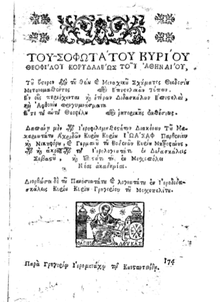Theophilos Corydalleus
Theophilos Corydalleus (Greek: Θεόφιλος Κορυδαλ(λ)εύς, Theofilos Koryda(l)leus; 1563–1646), was a Greek Neo-Aristotelian philosopher.

Biography
Corydalleus was born in Korydallos, which was renamed from Pachy in 1923 to honour him. He taught Italian, Greek, and Latin in Athens and Constantinople, and translated numerous texts from Latin, such as those by Cesare Cremonini, who was one of his teachers. He was appointed Director of the Academy of the Ecumenical Patriarchate of Constantinople in 1624 by Patriarch Cyril I.[1] The philosophy courses of Corydalleus are accurate accounts and commentaries of the treatises of Aristotle, written in Ancient Greek in the tradition of Alexandrine and neo-Aristotle commentators.
Modern criticism
Religious scholar Vasilios N. Makrides suggests that Corydalleus's Neo-Aristoteleian legacy was not an entirely positive one, stating that
By the end of the eighteenth century, it had become a hindrance to introducing new scientific ideas from Europe. This is why the Greek bearers of Enlightenment ideas criticized it, and why scores of scholars entered into debates about the validity of Neo-Aristotelianism and its place alongside Christian doctrine.[2]
In contrast, Anastasios Tamis believes that Corydalleus's appointment as director of the Academy
... was of paramount importance for the transmission of humanist and secular thought and culture into the Greek lands under the Turkish yoke. Corydalleus reorganised the Academy of the Patriarchate along the lines of Padua University, imposing a secular philosophy as the basis for higher education, and thus breaking away from its connection with theology.[3]
References
- Tamis, Anastasios M (2005). The Greeks in Australia. Cambridge, UK: Cambridge University Press. p. 11. ISBN 0-521-54743-1.
- Makrides, Vasilios N. (1 September 2009). Hellenic Temples and Christian Churches: A Concise History of the Religious Cultures of Greece from Antiquity to the Present. New York University Press. p. 278. ISBN 9780814795941. Retrieved 29 July 2018.
- Tamis, Anastasios (30 May 2005). The Greeks in Australia. Cambridge University Press. p. 11. ISBN 9780521547437. Retrieved 29 July 2018.